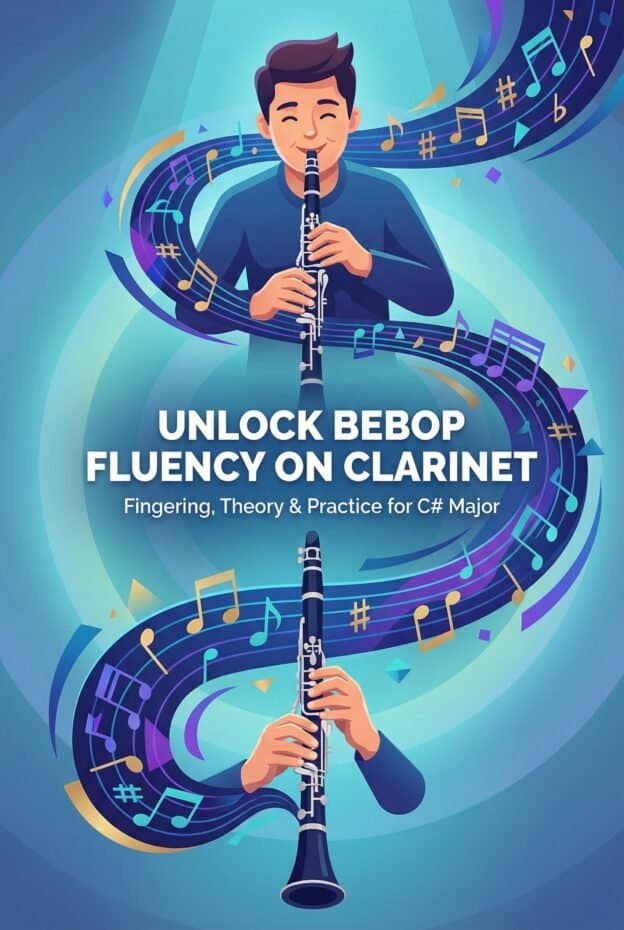The C# Bebop Major Scale is a C# major scale with an added chromatic passing tone (flat 7) between scale degree 6 and 7. On clarinet it is commonly fingered as C#-D#-E#(F)-F#-G#-A#-B-C#, and used to create flowing bebop lines over major harmony by lining up chord tones on strong beats.
Introduction: Why the C# Bebop Major Scale Matters for Clarinetists
The C# Bebop Major Scale helps clarinetists play clean bebop lines in sharp keys, especially over major chords and I chords in ii-V-I progressions. It solves a common jazz problem: how to keep chord tones on strong beats while playing continuous eighth notes. Mastering it also improves C# fingerings, intonation, and chromatic control.
For B-flat clarinet, written C# sounds as concert B. Jazz players meet this key in standards like tunes in B major or in modulations from E or F sharp. Practicing the C# bebop major pattern forces your fingers to handle awkward right-hand combinations and throat note coordination while your ear learns bebop voice-leading in a bright, sharp key center.
Free Clarinet Fingering Chart: C# Bebop Major Scale (Printable)
The written C# Bebop Major Scale for B-flat clarinet uses this note sequence ascending: C#-D#-E#(F)-F#-G#-A#-B-B#(C)-C#. The bebop passing tone is B natural between A# (6) and B# (7). Descending, many players omit the B natural or place it where it best fits the line rhythmically.
For a printable fingering chart, imagine a one-octave scale starting on written low C# (chalumeau) up to written C# above the staff. Each note is shown with standard Boehm-system fingerings and alternate options for fast passages. The chart should be laid out in two staves: one for notation, one for fingering diagrams, with arrows showing the added B natural.
Basic written fingering sequence, low C# to high C# (one octave plus passing tone):
- C# (low): Left-hand thumb, 1-2-3; right-hand 1-2-3; low C# key
- D#: Same as low E-flat: left thumb, 1-2-3; right 1-2; E-flat key
- E# (F): Standard low F fingering: left thumb, 1-2-3; right 1-2-3
- F#: Low F# key with right-hand little finger
- G#: Low G# side key with left-hand little finger
- A#: Same as B-flat: A key plus side B-flat or 1-1 B-flat fingering
- B: Standard B fingering: left thumb, 1-2; right 1-2-3
- B# (C): Standard low C fingering: left thumb, 1-2-3; right 1-2-3
- C#: Next-register C#: register key plus written C# fingering
For the middle and upper registers, the chart should show throat C#, side D#, long E#/F, and the clarion equivalents. Teachers can print and annotate the chart with circled alternates for problem spots, especially the shift from throat notes to clarion A# and B.
Understanding the Scale: Notes, Intervals, and Function
The C# Bebop Major Scale is built from the C# major scale with one added chromatic note. C# major has the notes C#, D#, E#, F#, G#, A#, B#, C#. The bebop major version inserts the flat 7 (B natural) between A# (6) and B# (7), giving 1, 2, 3, 4, 5, 6, b7, 7, 1.
Interval pattern in semitones from C#: +2 (D#), +2 (E#), +1 (F#), +2 (G#), +2 (A#), +1 (B), +1 (B#), +1 (C#). Functionally, chord tones (1, 3, 5, 6) can be placed on downbeats in continuous eighth notes over a major 6 or major 7 chord. The B natural acts as a passing tone that keeps the line flowing.
Over a C#maj7 chord, the scale outlines: C# (root), E# (3rd), G# (5th), B# (7th), with D# (9), F# (11), A# (13) as color tones and B (chromatic passing tone). This structure mirrors bebop practice from Charlie Parker and Dizzy Gillespie, where chromaticism supports, rather than obscures, the underlying harmony.
How to Use the C# Bebop Major Scale in Improvisation
Improvisers use the C# Bebop Major Scale mainly over C#maj6, C#maj7, and C#6/9 chords. On B-flat clarinet this corresponds to concert B major harmony. When you play straight eighth notes starting on a chord tone and use the bebop scale, chord tones naturally fall on the strong beats of the bar.
Try a simple exercise: Over a C#maj7 backing track, start on C# and play ascending eighth notes through the bebop scale for two bars. You will land on C# again on beat 1 of bar 3. Repeat starting on E# or G#. Notice how the B natural always feels like a quick, passing color between A# and B#.
In ii-V-I progressions in B major (for concert instruments), clarinetists can treat the I chord as C#maj7 in written pitch. For example, over a written ii-V-I of D#m7-G#7-C#maj7, use D# Dorian over ii, G# Mixolydian or altered over V, and C# Bebop Major over I. The bebop major sound signals resolution and stability after the tension of the V chord.
For bebop-style lines, mix arpeggios, scale fragments, and enclosures. Example in written pitch: G#-A#-B-B#-C#-B-A#-G# over C#maj7. Here the B natural connects A# to B# smoothly while your ear hears a clear C# major tonality with a jazzy chromatic twist.
Practice Exercises and Progressive Etudes (Beginner -> Advanced)
Start with slow, even eighth notes. Set a metronome to 60 bpm and play the C# Bebop Major Scale in one octave, then two octaves, ascending and descending. Focus on clean finger motion and consistent tone on C#, E#/F, and A#. Aim for a centered, slightly bright sound that projects well in jazz settings.
Once comfortable, move to articulation drills. Tongue every note at 72 bpm, then alternate slur-two-tongue-two patterns. Pay special attention to the throat notes D# and E#/F, which can sound thin if your voicing drops. Keep the tongue light and close to the reed, as in classic bebop clarinet playing from Buddy DeFranco.
Intermediate etude idea: Write a 4-bar phrase using only the C# Bebop Major Scale over a static C#maj7 chord. Use a mix of stepwise motion, small skips, and one or two larger intervals. Practice this phrase in all registers, including chalumeau, throat, and clarion, to unify your tone across the instrument.
Advanced exercise: Apply the scale to rhythm changes in B (concert). Over each I chord (written C#maj7), use bebop major lines that connect smoothly from the preceding V chord. Practice at 120-160 bpm, first with written etudes you create, then in free improvisation. Record yourself and check if chord tones land on strong beats consistently.
Transposition and Voice-Leading Variations for Different Keys
Once you know the C# Bebop Major Scale, you can transpose the bebop major pattern to any key. The formula is: 1, 2, 3, 4, 5, 6, b7, 7, 1. For example, in F major the notes are F, G, A, Bb, C, D, Eb, E, F. In G major they are G, A, B, C, D, E, F, F#, G.
For clarinet practice, move the C# bebop pattern around the circle of fifths. Start with C, G, D, A, E, B, then C#. Keep the same rhythmic shape but adjust the notes to fit each key. This builds transposition skill and reinforces the idea that bebop lines are often key-independent patterns adapted to new roots.
Voice-leading variations use the bebop major scale to connect chords smoothly. For example, in a ii-V-I in B major (written D#m7-G#7-C#maj7), you can end your G#7 line on B, then move B-B#-C# using the bebop scale to resolve into the I chord. The passing B natural gives a chromatic lift into the tonic.
Experiment with starting the bebop scale on different degrees. Starting on 3 (E#) gives a smoother, less root-heavy sound. Starting on 6 (A#) emphasizes the 6th and can suggest a major 6 sonority. Always keep the B natural as a passing tone, not a long-held note, so the line still clearly sounds like C# major.
Common Technical Problems & Troubleshooting
Many clarinetists struggle with C# and nearby chromatic notes. Low C# can sound flat or stuffy if your right-hand fingers are not fully sealing the tone holes. Check that the right-hand ring fingers stay curved and press firmly. For high C#, voicing too low can cause sagging pitch or squeaks when adding the register key.
The E#/F in the scale often feels resistant in fast passages. If the note speaks slowly, inspect the left-hand third finger and right-hand first finger for tension or partial coverage. Practice slow F-F#-G# and E#/F-F#-G# patterns, slurred, to smooth the transition. Use a mirror to ensure minimal finger lift.
Fuzzy articulation in bebop lines usually comes from a reed that is too soft or a tongue that moves too far. Choose a reed strength that allows clear attacks at soft dynamics without collapsing. Keep the tongue close to the tip of the reed and think of very short, light touches, especially at faster tempos above 120 bpm.
Finger confusion between A# and B natural is common in the C# bebop pattern. Decide on one primary A#/B-flat fingering (side key or 1-1) for scale practice, then add alternates later. Drill A#-B-B#-C# in repeated patterns until the motion feels automatic, both slurred and tongued.
Clarinet Anatomy & Maintenance Tips that Improve Execution
The C# Bebop Major Scale uses several sensitive areas of clarinet anatomy: the right-hand stack for low C# and D#, the throat tone holes for D# and E#/F, and the register key for clarion C# and above. Any leak or misalignment here will show up as weak tone or uneven response in this scale.
A simple schematic diagram would show the clarinet body with highlighted tone holes for C#, D#, F, and G#, plus the register key. Labels would indicate which fingers control each note and where cross-fingerings or side keys come into play. This visual helps students see why hand position and finger curvature matter so much in sharp-key bebop passages.
Pad height and spring tension affect how quickly keys close in fast lines. If the right-hand keys sit too low, low C# and D# can sound muffled. If they sit too high, the tone can be bright but unstable. A technician can adjust key height so that the C# and D# speak clearly without extra effort, which is important for rapid bebop articulation.
Regular key oiling keeps motion smooth. Apply a tiny drop of key oil to pivot screws and rods every 3-6 months, wiping away excess. Check the thumb rest height so your right hand can relax while reaching low C# and D#. A slightly higher thumb rest often helps players keep curved fingers and avoid collapsing onto the tone holes.
Barrel length affects pitch in sharp keys like C#. A slightly longer barrel or pulling out at the barrel can tame sharpness in the upper register, especially on high C# and D#. Always tune carefully with a tuner in C# major patterns so you learn how your instrument behaves in this key, not only in open G or long B-flat.
Historical Context and Notable Clarinetists (Archive References)
The bebop major scale concept grew from the 1940s bebop movement led by Charlie Parker and Dizzy Gillespie. While they did not always label scales formally, their lines over major chords often used added chromatic passing tones that later theorists described as bebop scales. Recordings like Parker's 1945 “Ko-Ko” and Gillespie's “Groovin' High” show this approach.
Clarinetists such as Buddy DeFranco brought bebop language to the clarinet. His 1950s recordings, including “Buddy DeFranco and Oscar Peterson Play George Gershwin,” contain many lines that fit bebop major and dominant patterns in sharp keys. Listening closely to his solos reveals how he navigates keys like B and E using chromatic passing tones similar to the C# bebop major structure.
Archival resources like the Library of Congress jazz collections, Smithsonian Jazz oral histories, and DownBeat magazine archives provide interviews and transcriptions that document how bebop musicians thought about scales and chord tones. Many describe practicing scales in all keys, including difficult ones like C# major, to gain complete technical freedom.
Within the broader history of band instruments, brands such as Martin Freres contributed to the spread of clarinet playing in jazz and dance bands. Historical catalogs and surviving instruments in the Martin Freres archive show how clarinets evolved to support more agile keywork, which later made fast bebop playing in sharp keys more accessible to skilled players.
Composing with the C# Bebop Major Scale & Suggested Repertoire
Composers and improvisers can use the C# Bebop Major Scale to craft heads, etudes, and solos that sit naturally over C#maj7 or C#6 chords. Start by writing an 8-bar melody that uses mostly stepwise motion in the scale, with the B natural appearing as a quick passing note. Aim for clear phrase shapes and strong-beat chord tones.
For clarinet students, writing short bebop etudes in C# major builds both theory understanding and finger fluency. Try composing a 16-bar chorus over a simple blues in B (concert), using the C# bebop major sound on the I chord and related bebop scales on the IV and V chords. This connects scale practice directly to real jazz forms.
Suggested repertoire for applying this scale includes standards that modulate to or sit near B major in concert pitch. Tunes with bright, modern harmonies often touch on these sharp keys. Teachers can assign transcribed solos that feature bebop major language, then have students identify where the passing flat 7 appears between scale degrees 6 and 7.
A clear learning goal is to perform a short, written solo excerpt that uses the C# Bebop Major Scale cleanly at 120 bpm, with accurate articulation and intonation. Once that feels secure, students can compose their own 8-16 bar bebop line using the scale and perform it with a play-along track or small ensemble.
Resources, Downloads, and Further Reading
For ongoing study, collect a set of resources that reinforce the C# Bebop Major Scale from multiple angles. A printable fingering chart for C# bebop major, including alternates and register transitions, should be part of every jazz clarinet folder. Teachers can annotate this chart with personal tips and metronome goals for each student.
Music theory texts on bebop scales, jazz harmony, and voice leading help clarify why the added flat 7 is so effective over major chords. Look for chapters that discuss bebop major and dominant scales, chord-tone targeting, and chromatic approach tones. Pair this reading with transcriptions of solos by Charlie Parker, Dizzy Gillespie, and Buddy DeFranco.
Online archives such as Smithsonian Jazz and the Library of Congress audio collections offer primary recordings where bebop language in sharp keys can be heard clearly. Listening while following along with a transcription in C# major trains both ear and fingers. DownBeat magazine back issues often contain interviews where players describe their scale practice routines.
Finally, keep a practice log that tracks your progress with the C# Bebop Major Scale. Note metronome markings, articulation patterns, and which ii-V-I progressions you have applied the scale to. This written record makes it easier to set new goals, such as reaching 160 bpm or composing a complete chorus using the scale.
Key Takeaways
- The C# Bebop Major Scale is C# major with an added flat 7 (B natural) between A# and B#, giving 1, 2, 3, 4, 5, 6, b7, 7, 1.
- On B-flat clarinet it is used mainly over written C#maj6/7 chords (concert B major) to keep chord tones on strong beats in continuous eighth notes.
- Technical success depends on solid C# and D# fingerings, clear E#/F response, light articulation, and a well-maintained instrument.
- Target outcomes include playing the scale at 120-160 bpm, applying it to ii-V-I progressions, and composing 8-16 bar bebop lines that use the passing B natural effectively.
FAQ – Common Questions About the C# Bebop Major Scale
What is C# Bebop Major Scale?
The C# Bebop Major Scale is a C# major scale with an added chromatic passing tone, the flat 7 (B natural), between the 6th degree (A#) and the 7th degree (B#). This 9-note scale allows chord tones to fall on strong beats when you play continuous eighth notes over C# major harmony.
How do I finger the C# Bebop Major Scale on B-flat clarinet?
On B-flat clarinet, start on written C# and use standard C# major fingerings, inserting B natural between A# and B#. In one octave: C#, D#, E#(F), F#, G#, A#, B, B#(C), C#. Use your usual A#/B-flat fingering and standard B fingering, keeping fingers curved and close to the keys for speed.
How can I practice the C# Bebop Major Scale to use it in solos?
Practice slowly at 60-80 bpm, slurred, then add light articulation. Next, play the scale over a C#maj7 backing track in continuous eighth notes, starting on different chord tones. Create 4-8 bar phrases that use only the scale, then apply it to ii-V-I progressions where the I chord is C#maj7 in written pitch.
What are common problems when playing C# and how do I fix them?
Common issues include flat or stuffy low C#, unstable high C#, and finger confusion around A# and B. Fix them by checking right-hand seal on low notes, raising voicing slightly for high C#, and drilling A#-B-B#-C# patterns. Ensure your instrument has no leaks and that your reed responds clearly in sharp keys.
How does the bebop major scale differ from the regular major scale?
The regular major scale has 7 notes, while the bebop major scale adds an 8th scale degree as a chromatic passing tone, creating 9 notes total. In C# bebop major, the extra note is B natural between A# and B#. This added note lets chord tones fall on strong beats in straight eighth-note lines.
Where can I find recordings or solos that use the C# Bebop Major Scale?
You can hear bebop major language in recordings by Charlie Parker and Dizzy Gillespie, especially on major-key tunes. For clarinet-specific examples, listen to Buddy DeFranco's bebop-era recordings. While solos may not stay in C# throughout, the same bebop major concept appears whenever they improvise over major chords in sharp keys.







